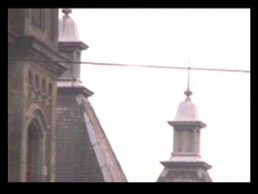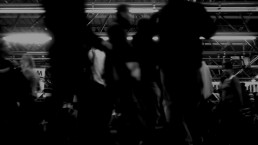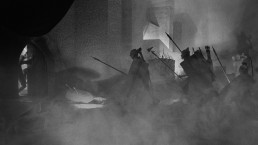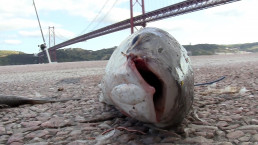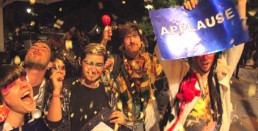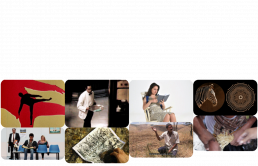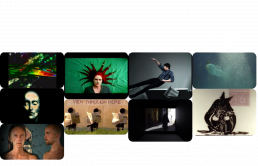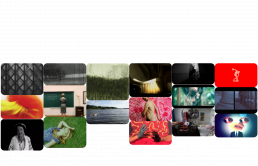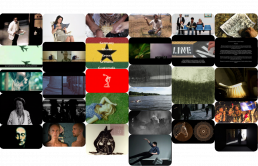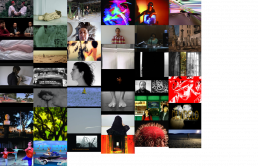“FUSO 2014 – 27 a 31 de Agosto“
Programação
27 Agosto, 22h
Praça do Carvão, Museu da Eletricidade
OPEN CALL – Secção competitiva Portugal 2014
Seleção de Jean-François Chougnet
O Open Call lançado pelo FUSO recebeu, este ano, mais de 120 candidaturas. Ao contrário dos anos anteriores, nenhuma temática foi sugerida. Apenas o formato (menos do que 10 minutos) e a data de realização foram incluídos como limitações.
Este é um panorama, certamente incompleto, nas tendências da videoarte concebida, produzida e fabricada em Portugal. Em termos artísticos, o advento da realidade virtual, da Internet e do digital é hoje central. Os artistas apresentados fazem parte da primeira geração que nasceu no advento destes desenvolvimentos tecnológicos e que se adaptou às mudanças constantes. A prática da performance é igualmente importante neste panorama e cruza, cada vez mais, a videoarte. A relação com o corpo tem, também, levado a muitas invenções plásticas, embora muitos artistas se identifiquem como narradores ou autobiógrafos, introduzindo ficções em torno da sua intimidade. Aqui objetos reais e quotidianos são os pontos de partida para algumas criações.
Nos últimos anos, testemunhámos também o surgimento do artista sob novas figuras nomeadamente como produtor, historiador, arquivista ou documentarista, em resposta a convulsões sociais e políticas contemporâneas.
Esta seleção de obras é baseada em duas “famílias”: a primeira, intitulada de Intervenções, inclui obras que se reconectam com algum “engagement”, uma evolução recente na arte em Portugal, ou obras que interpretam o real. A segunda, intitulada Apropriações, inclui vídeos com uma narração que capta histórias ou obras.
INTERVENÇÕES
Duração da sessão 59’
Diogo Antas da Cunha, Wanderlust, 2014, 4’02’’
“Estive no Porto inúmeras vezes nos últimos anos. No entanto, nunca levei a minha câmara com a intenção de fazer um vídeo completo e acabei sempre por me arrepender.
Dito isto, achei que era a oportunidade perfeita para finalmente realizar este desejo antigo. Desafiei o Gonçalo para me acompanhar e basicamente caminhámos pelo Porto durante 4 dias.
Vagueámos pelas ruas, parámos quando nos apeteceu e essencialmente capturámos tudo aquilo que nos chamou a atenção.
Tentei captar a verdadeira identidade da cidade e distanciar-me dos típicos postais, infinitamente retratados em centenas de vídeos. Esta é a minha visão do Porto, a minha experiência de contemplação.”
Paula Albuquerque, Portraying A’dam, 2014, 4’08’’
Parte do meu projeto que explora o potencial das webcams como um meio cinematográfico emergente, Portraying A’dam consiste numa abordagem documental à cidade de Amesterdão, fazendo uso exclusivo das webcams de acesso público disponíveis no dia 4 de Outubro de 2013. Este filme é composto por 3 capítulos, dos quais apenas o terceiro é mostrado no presente. Intitulado Face to Ground, este capítulo foca-se na extrema habilidade das câmaras em discernir e realçar as características faciais das pessoas, ao mesmo tempo que cobre uma enorme quantidade de outros detalhes.
Carlos Gomes, A Flicker of Life, 2014, 4’28’’
A junção de um plano fixo dos milhões de pessoas que todos os dias cruzam as suas existências no metro de São Paulo com um canto místico devocional da poesia Sufi, (Muwal al Burda, do poeta Sharaf ad-Din al-Busiri, 1212-1294). Ao longo dos séculos a letra original deste poema tem servido de base a novos poemas sufis, através da interpolação de outras frases entre as da letra original, fazendo reverberar até hoje o mito da sua criação bem com a vida do seu criador. Enquanto escutamos o poema, através de uma voz e sonoridade ancestrais, o vídeo capta a relação entre a câmara digital e os cátodos das lâmpadas fluorescentes da estação de metro, revelando o “flickering” observável no ecrã de vídeo. O “flickering” é intermediado e acentuado pela passagem das pessoas, que absortas nas suas vidas diárias, nem olham para a câmara que regista a fugaz cintilação da sua passagem. Uma metáfora poética e emocional da reflexão filosófica de Roger Scruton.
Nuno Lacerda, Mapa Museu, 2014, 8’08’’
Prémio do Público
Uma arquitetura fictícia suspensa no tempo e no espaço, tal como os seus habitantes.
Micael Espinha, Cinza, 2014, 10’
Partindo das imagens do Arquivo da Biblioteca de Arte – Fundação Calouste Gulbenkian, os autores criaram uma curta viagem ambiental, visual e sonora, por uma Cidade-Estado utópica e fantasmagórica. Nessa Lisboa imaginária, as centrais continuam a produzir eletricidade, os motores das locomotivas da novíssima rede de Metro trabalham em ponto morto, os néones e a iluminação noturna funcionam sem parar, a rádio continua a transmitir discursos de Salazar, mas não vislumbramos a mais leve presença humana, não está lá ninguém para ver e ouvir o pulsar da recém-chegada modernidade. Apenas estátuas e fachadas habitam a cidade.
Elsa Bruxelas, Pela Boca, 2012, 3’50’’
Uma perspetiva da vida segundo um olho de peixe.
Sara Leite, 40 de Abril, 2014, 9’28’’
Na noite de 24 de Abril de 2014, “rios” partiram de vários pontos da cidade com um objetivo comum: confluir no Largo do Carmo.
Após a Presidente da Assembleia da República ter negado a palavra aos Militares de Abril, no plenário nas celebrações oficiais dos 40 anos da revolução, a Associação 25 de Abril organizou uma manifestação alternativa, no Largo do Carmo.
Como antropóloga ainda novata e leiga a nível de captação de som e imagem, parti, sentindo que o gravador e a câmara eram as minhas armas, armas com as quais pouco treino tinha, para as celebrações da Revolução. Os meus objetivos centravam-se na exploração da reapropriação de símbolos, a multiplicidade de significados que uma data adquire quando se torna domínio da memória coletiva. Quis explorar os contrastes entre a noite e a manhã, entre o recordar e o reapropriar, o reviver e fazer acontecer.
Ana Borralho & João Galante + André Uerba, En Grève, 2014, 8’44’’
Um grupo de pessoas tenta criar uma imagem que represente uma ideia de greve.
Vídeo feito durante a adesão ao movimento de greve dos trabalhadores dos teatros em França, 2014.
Iria, A Cultura em PT, 2013, 1’
Num minuto, a Cultura (Artes) em Portugal – destinado a políticos.
Tiago Afonso, As Troianas, 2014, 5’40’’
«Pois nós somos inertes, compreendeis? Nada mais podemos, exceto esperar e padecer. Inertes, mas – pobres de nós! – conscientes.», As Troianas de Eurípides, Jean-Paul Sartre
“FUSO 2014 – August 27 to 31“
Program
August 27, 10pm
Praça do Carvão, Museu da Eletricidade
OPEN CALL – National competition 2014
Selection by Jean-François Chougnet
The Open Call launched by FUSO received more than 120 applications this year. Unlike previous editions, there was no suggested theme. Only the format (less than 10 minutes) and the date of completion were included as limitations.
This is certainly an incomplete panorama in the trends of video art conceived and produced in Portugal. In artistic terms, the advent of virtual reality, internet and digital is now central. The artists presented are part of the first generation that was born in the advent of these technological developments and adapted to never-ending changes. The practice of performance is equally important in this panorama and increasingly crosses the video art field. The relationship with the body has also led to many plastic inventions, although many artists identify themselves as narrators or autobiographers, introducing fictions around their intimacy. Here, real everyday objects are the starting point for some creations.
In recent years, we have also witnessed the artist’s emergence under new figures such as the producer, historian, archivist or documentary filmmaker, in response to contemporary social and political upheavals.
This selection of works is based on two “families”: the first, titled Interventions, includes works which reconnect with some engagement, a recent art evolution in Portugal, or works which interpret the real. The second, titled Appropriations, includes videos with a narration while capturing stories or works.
INTERVENTIONS
Total running time 59’
Diogo Antas da Cunha, Wanderlust, 2014, 4’02’’
“I’ve been in Oporto several times these last few years. However, I never took my camera with the intention of doing a complete video about it and always ended up regretting it.
Hereupon, I thought it would be the perfect opportunity to finally fulfill this old wish. I challenged Gonçalo to come along and we basically wandered around the city for 4 days.
We walked across the streets, stopped whenever we felt like it and basically captured what caught our attention.
I tried to capture the true identity of the city and to distance myself from the typical postcard images, endlessly portrayed in hundreds of videos. This is my vision of Oporto, my experience of contemplation.”
Paula Albuquerque, Portraying A’dam, 2014, 4’08’’
A part of my project exploring the potential of webcams as emerging cinematic medium, Portraying A’dam consists of a documental approach to the city of Amsterdam, exclusively making use of the publicly-accessible webcams available on the October 4th, 2013. This film is composed by three chapters of which only the third is shown. Titled Face to Ground, this chapter focuses on the extreme ability of the cameras to discern and highlight identifiable people’s facial features, while also covering an enormous amount of other details.
Carlos Gomes, A Flicker of Life, 2014, 4’28’’
The sum of a static shot with millions of people who every day cross their lives in the São Paulo’s subway with a mystical Sufi devotional singing (Muwal al Burda, from the poet Sharaf ad-Din al-Busiri, 1212-1294). Over the centuries the original lyrics of this poem has been the basis of new Sufi poems by interpolating some new lines after each original one, making the myth of its creation and the creator’s life reverberate until today. While we hear the poem, through an ancestral voice and sonority, the video captures the relationship between the digital camera and the cathodes of fluorescent lamps from the subway station, revealing the “flickering” featured in the video screen. The “flickering” is intermediated and punctuated by people passing by who, absorbed in their daily lives, do not look at the camera, which records the fleeting flicker of their walk. A poetic and emotional metaphor of the philosophical preposition by Roger Scruton.
Nuno Lacerda, Mapa Museu, 2014, 8’08’’
Audience Award
A fictitious arquitecture suspended in time and space, just like its inhabitants.
Micael Espinha, Cinza, 2014, 10’
Made entirely with photographs from the Calouste Gulbenkian Foundation – Art Library Archive, the authors created a short environmental journey through a utopian, ghost-like city-state. In this fictional Lisbon, power plants continue to produce energy, engines of the brand-new subway locomotives work in neutral shift, city lights and neon signs come alive each night and radio receivers spread Salazar’s (Portuguese Dictator) speeches – yet, nowhere is to be found the slightest human presence: there isn’t anyone to see and hear this pulse of fresh modernity. Only statues and facades inhabit the metropolis.
Elsa Bruxelas, Pela Boca, 2012, 3’50’’
A life perspective by a fish eye.
Sara Leite, 40 de Abril, 2014, 9’28’’
On the night of April 24th 2014, “rivers” departed from several parts of the city with one goal: to converge in Largo do Carmo.
After the President of the Republic Parliament denied the military’s speech at the official celebrations of the Revolution, April 25th Organisation prepared an alternative demonstration in Largo do Carmo.
As a rookie anthropologist and a lay person when it comes to recording sound and image, I went to the celebrations of the Revolution feeling as if the camera and the recorder were my weapons, which I did not know that well. My goals were to observe the appropriation of symbols, the multiplicity of meanings that a date can acquire when it becomes part of the collective memory. Also, to get in touch with the contrasts between night and morning, remembering and appropriating, between reliving and making something new happen.
Ana Borralho & João Galante + André Uerba, En Grève, 2014, 8’44’’
People trying to create an image which could translate a strike.
Produced while joining the strike movement of the theater workers in France, 2014.
Iria, A Cultura em PT, 2013, 1’
In one minute, Culture (The Arts) in Portugal – destined to politicians.
Tiago Afonso, As Troianas, 2014, 5’40’’
«For we are inert, see? We can do no more than waiting and grieving. Inert, but – unfortunately! – aware.» The Trojan Women of Euripides, Jean-Paul Sartre

